Putting out to sea can still be good,
Even if you can’t see too good.
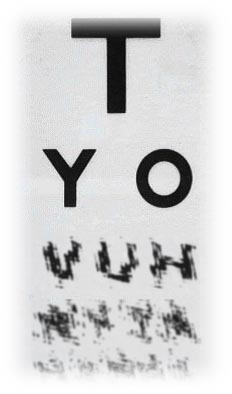 Being able to read the third row from the bottom of an eye chart is enough to get you a driving licence in the UK. As Captain Ben can barely manage the third row from the top with his good eye, driving a car has never been an option.
Being able to read the third row from the bottom of an eye chart is enough to get you a driving licence in the UK. As Captain Ben can barely manage the third row from the top with his good eye, driving a car has never been an option.
Even as a child I knew I’d never drive a car. Curiously though, I never doubted that I’d one day sail a boat.
I was raised to understand and respect the limitations my mediocre minces meant for me and to accept that there where things I would simply never be able to do. But I was also raised to believe that if there’s something I want in my life it’s down to me to find a way or make one and that if I had to give up then it shouldn’t be without a hell of a fight first.
With about a quarter of “normal” visual acuity in my good eye (and about 10% in the other) cheating my way to a driving licence, or even driving illegally without one, would have been stupid and reckless. I would have ended up killing someone – quite possibly myself – so I was content to readily admit defeat when it came to driving. The slower speeds, sparser traffic and vast spaces of the open sea on the other hand seemed a somewhat fairer game.
Sailing for the sub-sighted is not without its challenges but having clocked up a few thousand nautical miles now I’m pretty comfortable that I’ve become an effective crew member and that in time I’ll become an effective skipper too.
So if you too have a pair of piss-poor peepers yet fancy learning to sail a boat yourself, here are a few of the lessons I’ve learnt from my experiences so far.
Don’t ask, don’t tell
Pleasure sailing in the UK is essentially unregulated so no-one is going to make you sit an eye-test before letting you take a boat out. Less liberal countries do require you to earn some sort of skipper’s certificate before you are allowed take responsibility for a small craft at sea. The portable version of this is the International Certificate of Competence which in the UK you can obtain by simply demonstrating your competence, either via a day’s practical test or by successfully completing an RYA Day Skipper practical course. The details of any medical or physical problems you have are irrelevant; if you can demonstrate you’re competent then you’re in. The only time the details of your eyesight would become relevant is if you wanted commercially endorsed qualifications, necessary for example if you wanted to become a sailing instructor or run paid charters.
I’ve never been asked about my eyesight and I’ve never told skippers, instructors or crewmates about it. This is really just a personal choice since I have always chosen a level playing field for myself. My eyesight isn’t so bad that I can’t function perfectly adequately in my day-to-day life and so regard my lack of good vision in the same way that some people lack good maths or good physical strength or good co-ordination. Also if you want to be sure you can genuinely handle a boat as well as the next man, the only way you can be sure is if the people around you don’t know that you’re not quite the same as the next man and aren’t therefore quietly working around it.
Share or not is ultimately a matter for your own conscience based on your confidence in your coping skills and your willingness to accept the consequences of keeping your limitations to yourself.
More near…
One could be forgiven for presuming the problems of sailing with poor eyesight would be seeing things outside of the boat but if you’re eyesight is anything like mine most of your problems will probably lie inside of it.
The cockpit of the average sailboat is adorned with a variety of instrument panels which you’re going to need to keep a regular eye on to monitor speed, depth, wind direction, wind strength and even the engine RPM. Fortunately you don’t usually need to be constantly aware of these, a regular check will often be enough. Experience will eventually teach you to recognise the nature of the wind without needing to see the instruments and the engine note will tell you the RPM.
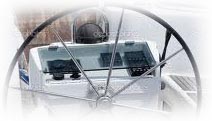 The steering compass on the other hand often requires a lot of attention as the affect of wind and tide on the boat can require constant tweaking of the helm to keep her on course. In many modern boats the compass readout will be on a nice big digital panel mounted behind the wheel and therefore really easy to see, but sometimes it will be mounted on the bulkhead several feet away from where you steer and on much older boats there may not even be a digital readout, just an old-school magnetic compass with tiny figures akin to those on the protractors you would have used in school maths lessons.
The steering compass on the other hand often requires a lot of attention as the affect of wind and tide on the boat can require constant tweaking of the helm to keep her on course. In many modern boats the compass readout will be on a nice big digital panel mounted behind the wheel and therefore really easy to see, but sometimes it will be mounted on the bulkhead several feet away from where you steer and on much older boats there may not even be a digital readout, just an old-school magnetic compass with tiny figures akin to those on the protractors you would have used in school maths lessons.
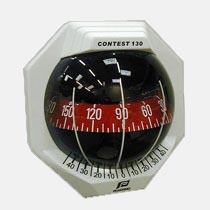 When coastal sailing you can often find something on the horizon to can use as a target to reduce the number of times you need to look at the compass. If planning to buy your own boat you also have the luxury of arranging your cockpit instruments to suit your abilities. If you find yourself sailing a boat where you can’t read the compass though there are a few workarounds you can use. A simple hand bearing compass you can wear round your neck should read the same as the master compass, as would a hand-held GPS or even an app on your smart phone. But being able to see the steering compass on a boat is by far the best solution so if you’re considering going sailing on someone else’s boat it’s worth considering how the cockpit instruments are laid out.
When coastal sailing you can often find something on the horizon to can use as a target to reduce the number of times you need to look at the compass. If planning to buy your own boat you also have the luxury of arranging your cockpit instruments to suit your abilities. If you find yourself sailing a boat where you can’t read the compass though there are a few workarounds you can use. A simple hand bearing compass you can wear round your neck should read the same as the master compass, as would a hand-held GPS or even an app on your smart phone. But being able to see the steering compass on a boat is by far the best solution so if you’re considering going sailing on someone else’s boat it’s worth considering how the cockpit instruments are laid out.
The inboard challenges don’t stop in the cockpit though. My boat has a 10 metre (30 foot mast) with lots of ropes and lines to support and trim those sails. If something gets tangled up top I have a pretty hard time working out what. A short-range monocular, binoculars or even the zoom function on a digital camera can come in handy here.
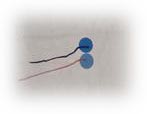 Trimming sails can be tricky too as you’re often looking for creases, flapping or the streaming of little “tell-tales” which can be hard to pick out, though experience eventually eliminates the need for these as you learn to tell simply from the feel of the boat how the sails need to be trimmed.
Trimming sails can be tricky too as you’re often looking for creases, flapping or the streaming of little “tell-tales” which can be hard to pick out, though experience eventually eliminates the need for these as you learn to tell simply from the feel of the boat how the sails need to be trimmed.
…Than far
Outside of the boat you need to be able to see other vessels, obstructions such as fishing net or pot buoys and also navigation marks – particularly when coming into or out of a port. On bright and sunny days the low-sighted are at something of a disadvantage here, though it’s important to remember that not all days are bright and sunny. In rain or in fog the visibility drops for everyone and even fully sighted sailors need some tricks and tools to sail safely.
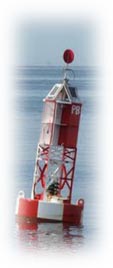 The landmarks, waymarks and seamarks used for pilotage are certainly a challenge for me. Buoys are often large and brightly coloured and since sailing boats proceed at a comparatively sedate speed I can usually spot them in good time. In quieter backwaters though seamarks can be rather basic (consider for example a black metal pole or bare branch marking a shallow rock). Landmarks, such as a chimney or a church steeple used to identify a safe approach bearing can be tricky too.
The landmarks, waymarks and seamarks used for pilotage are certainly a challenge for me. Buoys are often large and brightly coloured and since sailing boats proceed at a comparatively sedate speed I can usually spot them in good time. In quieter backwaters though seamarks can be rather basic (consider for example a black metal pole or bare branch marking a shallow rock). Landmarks, such as a chimney or a church steeple used to identify a safe approach bearing can be tricky too.
 Such marks have two main uses. They can be used to fix a position in the open water where there’s little danger close at hand and therefore plenty of time to try and find them with the naked eye or perhaps with the help of a pair of binoculars. There other main use is pilotage into or out of a port and this can be a bigger problem as there are often a succession of such marks you need to spot and the margin of error for straying off course is often much tighter. Again though it’s useful to remember that even sailors with perfect eyesight need to be able to cope without these marks when general visibility is bad and good navigators always ensure they have multiple ways of fixing their position and following their course. Handheld or cockpit mounted chart plotters, akin to the satnav in a car, can help give you confidence between spotting waymarks and carefully planning an approach so you know the course to steer or depth of the safe channel provides confidence too, something again that any good navigator would be doing. When looking for hard to see landmarks I often find using binoculars to spot them and then using the general terrain around them with the naked eye works fine.
Such marks have two main uses. They can be used to fix a position in the open water where there’s little danger close at hand and therefore plenty of time to try and find them with the naked eye or perhaps with the help of a pair of binoculars. There other main use is pilotage into or out of a port and this can be a bigger problem as there are often a succession of such marks you need to spot and the margin of error for straying off course is often much tighter. Again though it’s useful to remember that even sailors with perfect eyesight need to be able to cope without these marks when general visibility is bad and good navigators always ensure they have multiple ways of fixing their position and following their course. Handheld or cockpit mounted chart plotters, akin to the satnav in a car, can help give you confidence between spotting waymarks and carefully planning an approach so you know the course to steer or depth of the safe channel provides confidence too, something again that any good navigator would be doing. When looking for hard to see landmarks I often find using binoculars to spot them and then using the general terrain around them with the naked eye works fine.
And if a particular approach takes you too far out of your comfort zone, there’s always another port along the coast a way.
More of the same
Most of the problems I’ve had to deal with as a myopic mariner tend to be exactly the same problems every other sailor experiences, I just experience them more than they do. I can’t read berth numbers in most marinas for example, but most sailors have encountered at least one marina where they couldn’t read them either. Every sailor needs ways to cope with visibility problems, I just need them a bit more than they do.
If you have bad eyesight, bad enough to mean you can’t drive a car, it could be that it’s also bad enough to mean you can’t sail a boat either. But there’s a good chance it won’t, a good chance you’ll be able to sail just as effectively as the next man. If sailing is one of your dreams, it’s certainly worth giving it a go.